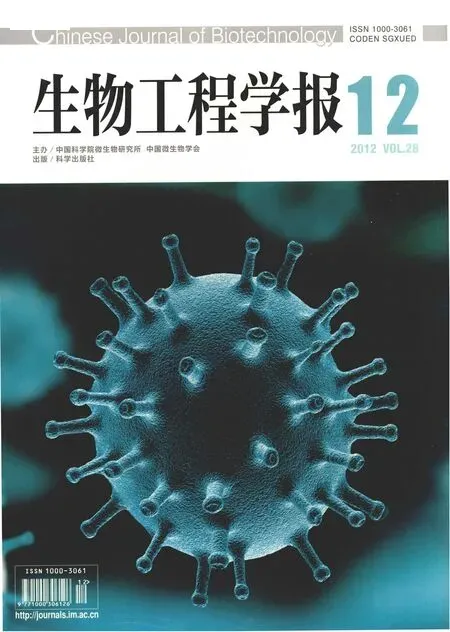表达O型口蹄疫病毒保护性抗原表位重组PRRSV的构建及其鉴定
2012-09-03童武徐彦召周艳君姜一峰张善瑞王亚欣朱建平虞凌雪孙晶陈焕春童光志
童武,徐彦召,周艳君,姜一峰,张善瑞,王亚欣,朱建平,虞凌雪,孙晶,陈焕春,童光志
1 中国农业科学院上海兽医研究所,上海 2002412 华中农业大学动物医学院,湖北 武汉 430070
表达O型口蹄疫病毒保护性抗原表位重组PRRSV的构建及其鉴定
童武1,2,徐彦召1,周艳君1,姜一峰1,张善瑞1,王亚欣1,朱建平1,虞凌雪1,孙晶1,陈焕春2,童光志1
1 中国农业科学院上海兽医研究所,上海 200241
2 华中农业大学动物医学院,湖北 武汉 430070
童武, 徐彦召, 周艳君, 等. 表达O型口蹄疫病毒保护性抗原表位重组PRRSV的构建及其鉴定. 生物工程学报, 2012,28(12): 1431−1440.
Tong W, Xu YZ, Zhou YJ, et al. Construction and identification of a recombinant PRRSV expressing protective antigens of type O foot-and-mouth disease virus. Chin J Biotech, 2012, 28(12): 1431−1440.
以高致病性猪繁殖与呼吸综合征弱毒疫苗的感染性分子克隆 (rHuN4-F112) 作为载体,将 O型口蹄疫病毒 (FMDV)VP1基因的421~480nt (141~160aa) 和598~639nt (200~213aa) 两优势保护性抗原表位串联成的目的基因,通过突变PCR的方法插入Nsp2中的508~532位缺失区域,经体外转录后转染至BHK-21细胞中培养36 h,将上清接种至MARC-145细胞中培养,并在MARC-145细胞中连续传代,拯救重组病毒。经RT-PCR扩增,MluⅠ酶切及测序验证,结果表明插入的外源基因及人为突变的MluⅠ分子标记都正确,说明重组病毒拯救成功,且该重组病毒能够在MARC-145细胞中稳定传代,将此重组病毒命名为rPRRSV-F112-O/VP1ep。rPRRSV-F112-O/VP1ep能够在MARC-145细胞上引起明显的细胞病变,间接免疫荧光检测表明外源基因在该病毒中成功获得了表达。经过生物学特性分析,该病毒的TCID50=-log10-6.75/0.1 mL, 且在MARC-145细胞中整体生长速度与其亲本病毒rHuN4-F112(△508-532) 相似,但明显高于rHuN4-F112病毒。
猪繁殖与呼吸综合症病毒,O型口蹄疫病毒,感染性分子克隆,重组病毒
口蹄疫 (FMD) 是由口蹄疫病毒 (FMDV)引起的一种烈性传染病,该病主要感染猪、牛、羊等重要偶蹄动物。由于FMDV的危害性极大,暴发该病不仅给发病国家或地区的畜牧业造成巨大经济损失,而且还会引起一系列政治和社会问题。FMDV共分为7个血清型,各血清型之间交叉保护性极差,且不同血清型的亚型和分离株间抗原的差异性很大。目前,对于口蹄疫的预防主要以免疫接种为主,常用口蹄疫疫苗主要有灭活疫苗、合成肽疫苗两种[1-2]。1982年 Bittle等首次用化学合成的方法,合成FMDV VP1蛋白基因上的第141~160位和200~213位氨基酸短肽免疫动物成功获得了保护[3]。Morgan等分别采用原核表达的方法,成功表达了FMDV A12株VP1蛋白基因上的第137~168位氨基酸的二聚体及单体,将这2种融合蛋白分别免疫动物,都能成功获得保护,且二聚体的保护效果较单体好[4]。
猪繁殖与呼吸综合征 (PRRS) 是由猪繁殖与呼吸综合征病毒 (PRRSV) 引起的以怀孕母猪流产、死胎、木乃伊胎,仔猪呼吸道疾病为主要特征的一种传染病[5-7]。2006年南方大部分省市爆发的以高致病性PRRSV为主要病原的“高热病”给我国养猪行业带来了巨大的损失[8-12]。由于PRRSV能使猪体产生免疫抑制,PRRSV疫苗和FMDV疫苗同时免疫时,会导致FMDV疫苗免疫失败,利用PRRSV作为载体开发新型的PRRS-FMD二联疫苗将可以有效解决这一问题。方莹等在PRRSV感染性分子克隆的基础上,在Nsp2的非必需区中插入增强型绿色荧光蛋白(EGFP) 序列,拯救重组病毒,结果显示能够成功拯救出含有EGFP基因的重组病毒,但随着子代病毒在细胞上的传代,EGFP基因序列发生了突变及缺失,进而丧失了EGFP活性[13-16]。徐彦召等在PRRSV HuN4-F112疫苗株的反向遗传操作平台的基础上,选择抗原性强的NDVNP49基因作为标记基因,成功构建了含有标记基因的PRRSV的感染性克隆并拯救出病毒,且拯救出的子代病毒在细胞上能稳定地传代[17-18]。因此,在本实验中,我们将 FMDV VP1基因上的141~160位和200~213位氨基酸的优势细胞表位经 (G4S)2串联后插入 PRRSV感染性分子克隆rHuN4-F112(508△-532)[19]中的Nsp2缺失区,希望可以拯救出含有口蹄疫病毒保护性抗原表位的重组PRRSV。
1 材料与方法
1.1 试剂
PRRSV HuN4-F112的感染性分子克隆由本实验室构建[20-21];抗PRRSV核衣壳 (N) 蛋白的单抗 (鼠源)[22-23],由本实验室制备并保存;FMDV typeO VP1 141~160,200~213的多克隆抗体 (猪源) 由中国农业科学院兰州兽医研究所馈赠;RNeasy Plus Mini Kit试剂盒购自QIAGEN公司,胶回收试剂盒,提质粒试剂盒购自上海华舜生物科技有限公司;DpnⅠ,PacⅠ,ClaⅠ,SwaⅠ及T4 DNA连接酶购自NEB公司;FITC标记羊抗鼠 (Alexa Fluor 568) 和羊抗猪 (Alexa Fluor 488) 荧光抗体,RNA转染试剂DMRIE-C reagent购自Invitrogen公司;PfuUItra 11 Fusion HS DNA聚合酶购自Stratagene公司;体外转录试剂盒 mMessage High Yield Capped RNA Transcription Kit购自Ambion公司。
1.2 插入FMDV基因片段的引物设计及目的基因获得
参照PRRSV F112核苷酸序列,在插入位置两端设计了一对鉴定引物P2701和P3192。结合NCBI中提交部分的FMDV type OVP1基因的全序列,经DNAstar软件比对并输出共有序列,然后再分别截取共有序列中的 141~160,200~213位氨基酸残基的核苷酸序列经 (G4S)2串联后共同组成插入的外源基因序列,大小为132 bp。外源基因序列加上插入位置两端各20 bp组成目的基因序列,大小为172 bp。设计了OUP1、ODP2、ODP3、ODP4、ODP5五条引物,采用PCR的方法对目的基因进行拼接。引物序列见表1。
1.3 含有外源基因的 rHuN4-F112-ABC(△508-532) 重组质粒的获得
将上述得到的 FMDV外源基因片段采用突变 PCR的方法插到 rHuN4-F112 Nsp2(508△-532)[19]处。突变PCR的反应体系:10×PfuUItra 11 反应缓冲液 5 μL;dNTPs (10×) 1.25 μL;rHuN4-F112-ABC (508△-532)[19]质粒需换算(5~30 ng);外源基因 1 μL (10 μmol/L 左右);PfuUItra 11 Fusion HS DNA聚合酶1 μL;补水至50 μL。PCR反应条件:92 ℃2 min;92 10℃ s,55 20℃ s,68 7℃ min 30 s,22个循环;68 5℃min;4 ℃保存。将突变 PCR反应液用DpnⅠ37 ℃酶切6 h,转化至K12感受态涂含氨苄平板中培养,挑阳性菌测序验证,并提取质粒保存备用。

表1 目的基因的扩增引物及鉴定引物Table 1 Primers for amplification and identification of target gene
1.4 含外源基因的rHuN4-F112(△508-532)全长cDNA连接
将上述提取的含 FMDV外源基因片段的rHuN4-F112-ABC (508△-532)[19]质粒和rHuN4-F112-DEF[20]质粒分别用PacⅠ和ClaⅠ双酶切后,用华舜的胶回收试剂盒回收相应的基因片段,并用 T4 DNA连接酶连接成含外源基因的rHuN4-F112(508△-532)[19]cDNA全长质粒。并用SwaⅠ将含外源基因的rHuN4-F112(△508-532)cDNA全长质粒线性化。
1.5 重组病毒的体外转录及转染
根据体外转录试剂盒说明合成重组病毒RNA;并参照DMRI-C reagent转染试剂操作说明将转录合成的 RNA转染至 70%~90%单层的BHK-21细胞中;转染24~36 h取细胞上清液接种至MARC-145细胞,观察CPE,并连续传代[24]。
1.6 rPRRSV-F112-O/VP1ep的鉴定及其生物学特性分析
1.6.1 rPRRSV-F112-O/VP1ep中外源基因及分子标记的鉴定
分别提取拯救病毒的第 3、5、10、15、20代毒的RNA利用鉴定引物P2701、P3192及实验室保存的MluⅠ鉴定引物进行RT-PCR扩增,将MluRTⅠ-PCR产物用MluⅠ酶切,并电泳观察结果;同时把P2701、P3192 RT-PCR反应液用P2701引物送公司测序验证。
1.6.2 间接免疫荧光 (IFA) 鉴定
将拯救病毒的第 5代毒和其亲本毒接种MARC-145细胞后48 h后弃培养液。用80%预冷的乙醇 4 ℃固定 1 h,用 1∶500稀释的抗PRRSV N蛋白的单克隆抗体为一抗,以FITC标记羊抗鼠抗体为二抗检测拯救的重组病毒。同时用1∶180稀释的FMDV typeO VP1 141~160,200~213的多克隆抗体孵育1 h,再用FITC标记羊抗猪抗体来反应。置荧光显微镜下观察。
1.6.3 rPRRSV-F112-O/VP1ep的TCID50测定
预先将MARC-145细胞在96孔细胞培养板中培养至单层,再将拯救病毒第 5代毒进行10-1~10-10十倍倍比稀释,分别接种到96孔细胞培养板中,每个稀释度接种8孔,最后两列孔不接毒作对照,置于 37 ℃、5% CO2的细胞培养箱中培养,96 h后观察CPE,按照Reed-Muench法计算重组病毒的TCID50[24]。
1.6.4 rPRRSV-F112-O/VP1ep的生长曲线测定
以第 5代拯救病毒和其亲本毒都以 100个TCID50的毒量接种 MARC-145细胞,分别在接毒后不同的时间点 (12、24、36、48、60、72、84、96 h) 收取细胞上清液,分别进行病毒的TCID50测定,根据测定结果绘制成曲线[24]。
2 结果
2.1 rPRRSV-F112-O/VP1ep全长 cDNA的构建
利用引物 (OUP1,ODP2,ODP3,ODP4,ODP5) 进行PCR扩增获得172 bp的目的基因片段 (图1)。采用突变PCR的方法获得了含FMDV type OVP1两优势表位的重组rHuN4-F112-ABC(508△-532) 的质粒,用鉴定引物P2701和P3142鉴定,插入后扩增的片段大小为549 bp (图2)。用PacⅠ和ClaⅠ双酶切并拼接成含FMDV type OVP1两优势表位的全长rHuN4-F112(△508-532)质粒。最后用SwaⅠ将该重组的全长质粒线性化。
2.2 rPRRSV-F112-O/VP1ep所引起的细胞病变
将线性化好的重组质粒根据体外转录试剂盒说明合成重组病毒 RNA;并参照 DMRI-C reagent转染试剂操作说明将转录合成的RNA转染至BHK-21细胞中;转染24~36 h取细胞上清液接种至 MARC-145细胞,连续传代,在MARC-145细胞在传至第2代时就出现了明显的细胞病变 (图3)。
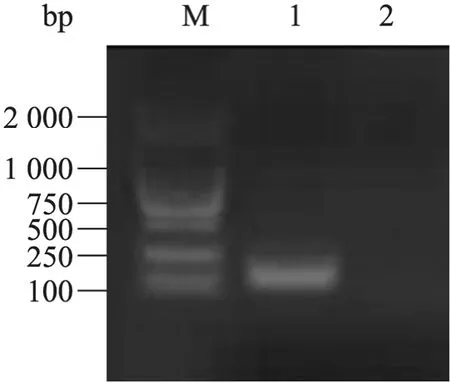
图1 目的基因的获得Fig. 1 PCR amplification of target gene. M:DL-2000DNA maker; 1: target gene of FMDV; 2: mock.
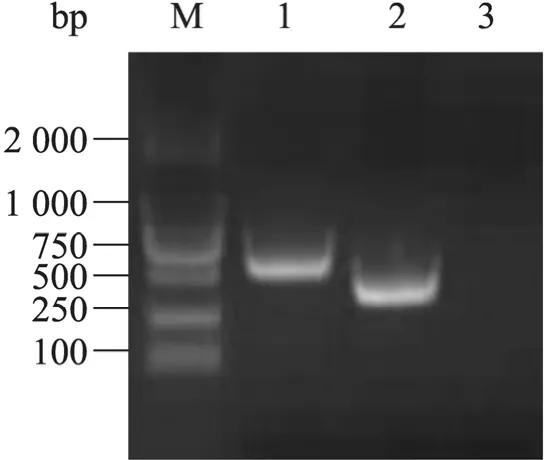
图2 重组质粒的构建Fig. 2 Construction of recombinant plasmid. M:DL-2000DNA maker; 1: size of recombinant plasmid; 2:size of r HuN4-F112-ABC (△508-532); 3: mock.
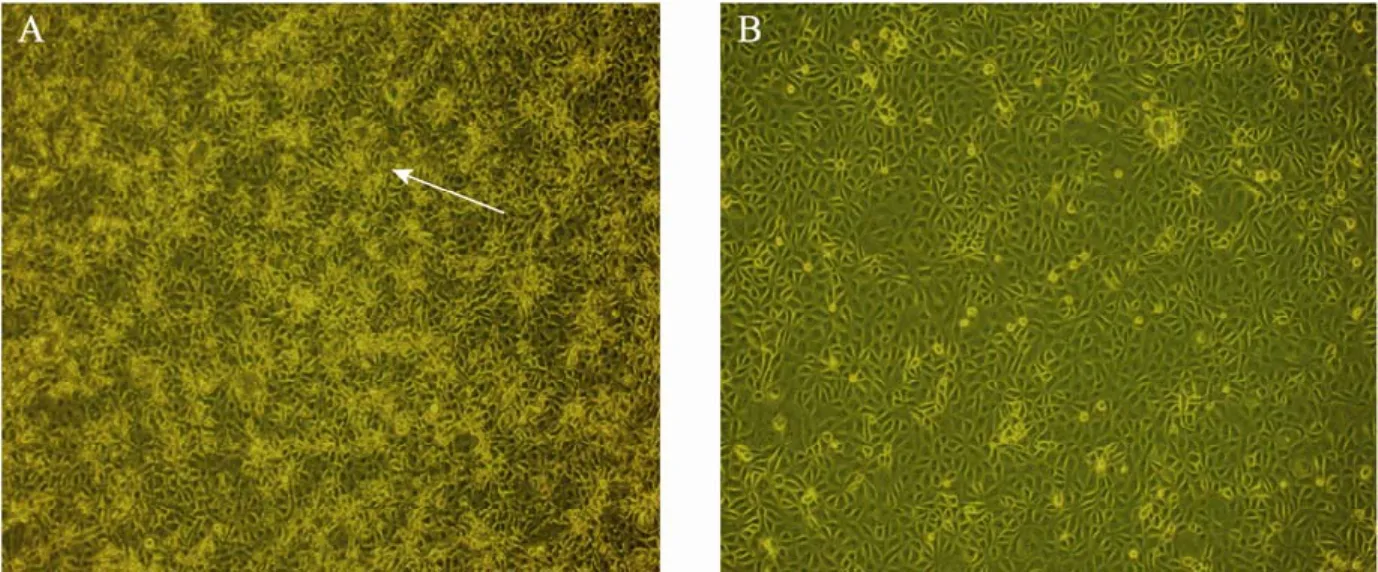
图3 rPRRSV-F112-O/VP1ep引起的MARC-145细胞病变Fig. 3 MARC-145 cells infected with PRRSV-F112-O/VP1ep. (A) MARC-145 cells infected with rPRRSV-F112-O/VP1ep virus. (B) Normal MARC-145 cells.
2.3 rPRRSV-F112-O/VP1ep中外源基因及分子标记的鉴定
提取第3、5、10、15、20代rPRRSV-F112-O/VP1ep的 RNA经 P2701、P3192及MluⅠ鉴定引物进行RT-PCR的扩增,鉴定结果均成立(图 4,5)。并将第 3、5、10、15、20代重组病毒的RT-PCR反应液送测序,比对结果证明其外源基因都稳定存在 (图6)。
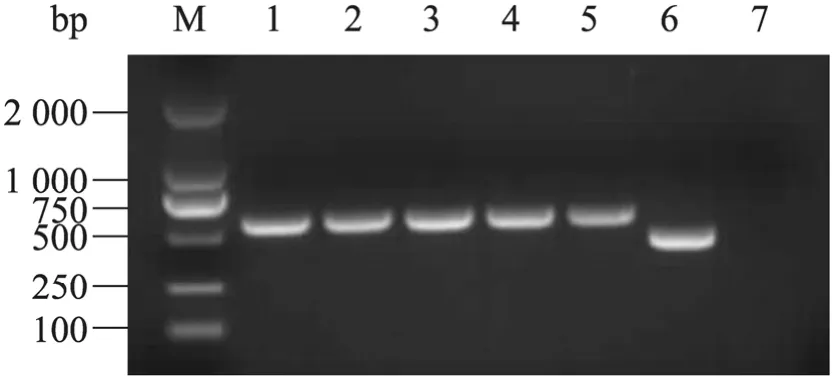
图4 拯救病毒的RT-PCR鉴定Fig. 4 Identification of rescued PRRSV by RT-PCR.M: DNA maker DL-2000; 1−5: RT-PCR of rPRRSVF112-O/VP1ep at 3th, 5th, 10th, 15th, 20th passage; 6:RT-PCR of r HuN4-F112(△508-532); 7: mock.
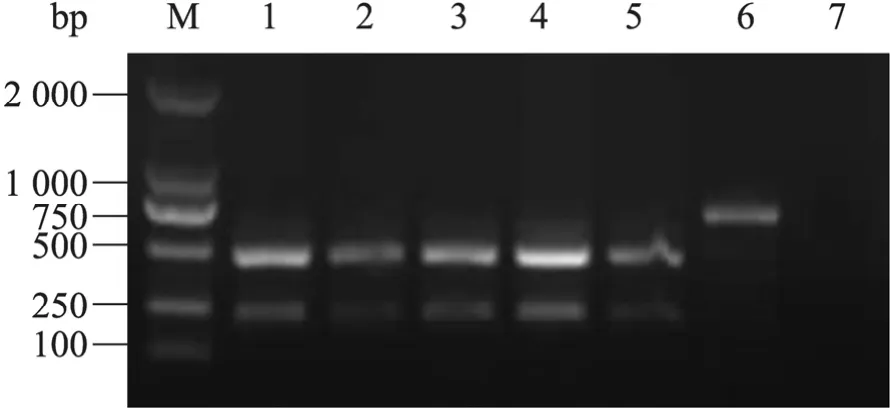
图5 拯救病毒及野生型病毒的Mlu Ι酶切鉴定Fig. 5 RT-PCR products of rescued virus and wild type virus digested with Mlu Ι. M: DNA marker DL-2000;1−5: RT-PCR of rPRRSV-F112-O/VP1ep at 3th, 5th, 10th,15th, 20th passage digestion with Mlu Ι; 6: RT-PCR of wild type virus digestion with Mlu Ι; 7: mock.
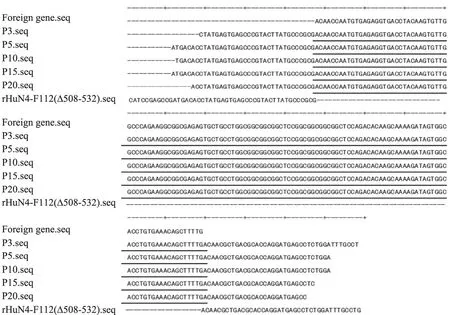
图6 rPRRSV-F112-O/VP1ep第3、5、10、15、20代毒外源基因测序结果Fig. 6 Sequence determination of inserts in rPRRSV-F112-O/VP1ep at 3th, 5th, 10th, 15th, 20th passage.
2.4 rPRRSV-F112-O/VP1ep的IFA鉴定
将rPRRSV-F112-O/VP1ep的第 5代毒和其亲本毒以100个TCID50的毒量接种MARC-145细胞48 h后弃培养液。都能与1∶500稀释的抗PRRSV N蛋白的单克隆抗体结合,且都出现了特异性的荧光,rPRRSV-F112-O/VP1ep也能与1∶180稀释的 FMDV typeO VP1 141~160,200~213的多克隆抗体反应 (图7)。
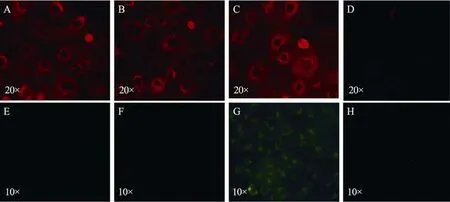
图7 rPRRSV-F112-O/VP1ep及其亲本毒的间接免疫荧光检测结果Fig. 7 IFA detection of rPRRSV-F112-O/VP1ep and its parental viruses. IFA detection was performed on MARC-145 cells infected respectively, with rHuN4-F112 (A, E), rHuN4-F112(△508-532) (B, F), or rPRRSV-F112-O/VP1ep (C,G) using antibodies against PRRSV N protein (A, B, C, D) or FMDV vp1 protein (E, F, G, H). (D) and (H) are normal MARC-145 cells without infection.
2.5 rPRRSV-F112-O/VP1ep生长滴度测定
将 rPRRSV-F112-O/VP1ep第 5代毒进行10-1~10-10十倍倍比稀释,接至96孔MARC-145细胞培养板中,每个稀释度接种8孔,留两列作对照,置于37 ℃、5% CO2的细胞培养箱中培养,96 h后观察CPE,按照Reed-Muench法计算rPRRSVF112-O/VP1ep 的 TCID50=−log10−6.75/0.1 mL。
2.6 rPRRSV-F112-O/VP1ep的生长曲线绘制
以第5代rPRRSV-F112-O/VP1ep和其亲本毒都以 100个 TCID50的毒量接种 MARC-145细胞,分别在接毒后不同的时间点收取细胞上清液,分别进行病毒的 TCID50测定,根据测定结果绘制成曲线。结果显示重组病毒在MARC-145细胞中的生长速度明显高于其亲本毒 (图 8)。
3 讨论

图8 重组病毒rPRRSV-F112-O/VP1ep及其亲本毒在MARC-145细胞上的多步生长曲线Fig. 8 Growth curve detection of rPRRSV-F112-O/VP1ep and its parental viruses on MARC-145 cells.
现今临床中所用的 FMDV疫苗主要还是灭活疫苗和合成肽疫苗[1-2],由于PRRSV能使猪体产生免疫抑制,PRRSV疫苗和FMDV疫苗同时免疫时,会导致 FMDV疫苗免疫失败,利用PRRSV作为载体开发新型的PRRS-FMD二联疫苗也是很有意义的一项研究。Bittle和Morgan等也都分别证实了 FMDVVP1基因上的 141~160位和200~213两表位是FMDV的主要保护性抗原,能抵抗同源FMDV强毒的攻击[3-4]。徐彦召等在PRRSV HuN4-F112疫苗株的反向遗传操作平台的基础上,选择抗原性强的NDVNP49基因作为外源标记基因,成功构建了含有外源标记基因的PRRSV的感染性克隆并拯救出病毒,且拯救出的子代病毒中的NP49基因在细胞上能稳定地传代并获得表达。将含NP49的重组 PRRSV接种实验猪,能够抵抗PRRSV强毒的攻击,且能从猪体内检测到针对NP49的抗体[17-18]。为PRRSV标记疫苗候选株提供了实验材料,也为本研究奠定了基础。
本研究以高致病性猪繁殖与呼吸综合征弱毒疫苗的感染性分子克隆 (rHuN4-F112) 作为载体,采用突变PCR的方法将O型口蹄疫病毒(FMDV)VP1基因的141~160位和200~213位两保护性抗原表位串联后,插入到Nsp2中的508~532位缺失区域,经体外转录后转染至BHK-21细胞中培养36 h,将上清接至MARC-145细胞中连续传代,成功拯救出了含 FMDV保护性抗原的重组病毒。且重组病毒中的外源基因能够在MARC-145细胞中稳定传代并得到表达。为PRRS-FMD二联苗提供了候选疫苗株。
本研究验证了PRRSVNsp2的非必需区的存在,为PRRSV表达外源基因提供了实验数据,也进一步证明了PRRSV对外源基因的耐受性。为PRRSV标记疫苗的研究提供了理论基础,同时也为PRRSV二联苗的研究提供了新的方向。
[1]Shao JJ, Chang HY. Advances in multiple-epitopes vaccines against foot-and-mouth disease. Chin Vet Sci, 2008, 38(11): 1009−1012.
邵军军, 常惠芸. 口蹄疫多表位疫苗的研究进展.中国兽医科学, 2008, 38(11): 1009−1012.
[2]Ma LN, Liu YS, Chen HT, et al. Development of synthetical peptide vaccine of foot and mouth disease. Chin Agric Sci Bull, 2009, 25(13): 18−22.
马丽娜, 刘永生, 陈豪泰, 等. 口蹄疫合成肽疫苗研究进展. 中国农学通报, 2009, 25(13): 18−22.
[3]Bittle JL, Houghten RA, Alexander H, et al.Protection against foot-and-mouth disease by immunization with a Chemically synthesized peptide predicted from the viral nucleotide sequence. Nature, 1982, 198(5869): 30−33.
[4]Morgan DO, Moore DM. Protection cattle and swine against foot-and-mouth disease, using biosynthetic peptide vaccines. Am J Vet Res, 1990,51(1): 40−45.
[5]Bilodeau R, Dea S, Sauvageau RA, et al. ‘Porcine reproductive and respiratory syndrome’ in Quebec[letter]. Vet Rec, 1991, 129(5): 102−103.
[6]Pol JM, van Dijk JE, Wensvoort G, et al.Pathological, ultrastructural, and immunohistochemical changes caused by Lelystad virus in experimentally induced infections of mystery swine disease (synonym: porcine epidemic abortion and respiratory syndrome (PEARS). Vet Quart, 1991, 13(3): 137−143.
[7]Christianson SA, Nilsson LG, Säisä J, et al. Visual half-field testing of memory functions in patients considered for surgical treatment of intractable complex partial epilepsy. Acta Neurol Scand, 1992,86(6): 545−554.
[8]Tong GZ, Zhou YJ, Hao XF, et al. Identification and molecular epidemiology of the very virulent porcine reproductive and respiratory syndrome viruses emerged in China. Chin J Prevent Vet Med,2007, 29(5): 323−326.
童光志, 周艳君, 郝晓芳, 等. 高致病性猪繁殖与呼吸道综合征病毒的分离鉴定及其分子流行病学分析. 中国预防兽医学报, 2007, 29(5):323−326.
[9]Tian KG, Yu XL, Zhao TZ, et al. Emergence of fatal PRRSV variants: unparalleled outbreaks of atypical PRRS in China and molecular dissection of the unique hallmark. PLoS ONE, 2007, 2(6): e526.
[10]Tong GZ, Zhou YJ, Hao XF et al. Highly pathogenic porcine reproductive and respiratory syndrome, China. Emerq Infect Dis, 2007, 13(9):1434−1436.
[11]Zhou YJ, Hao XF, Tian ZJ et al. Highly virulent porcine reproductive and respiratory syndrome virus emerged in China. Transboun Emer Dise,2008, 55(3/4): 152−164.
[12]Zhou Z, Ni J, Cao Z, et al. The epidemic status and genetic diversity of 14 highly pathogenic porcine reproductive and respiratory syndrome virus(HP-PRRSV) isolates from China in 2009. Vet Microbiol, 2011, 150(3/4): 257−269.
[13]Fang Y, Christopher-Hennings J, Brown E, et al.Development of genetic markers in the non-structural protein 2 region of a US type 1 porcine reproductive and respiratory syndrome virus: implications for future recombinant marker vaccine development. J Gen Virol, 2008, 89(Pt 12):3086−3096.
[14]Fang Y, Rowland R R, Roof M, et al. A full-length cDNA infectious clone of North American type 1 porcine reproductive and respiratory syndrome virus: expression of green fluorescent protein in the Nsp2 region. J Virol, 2006, 80(23): 11447−11455.
[15]Han J, Liu GP, Wang Y, et al. Identification of nonessential regions of the nsp2 replicase Protein of porcine reproductive and respiratory syndrome virus strain VR-2332 for replication in cell culture.J Virol, 2007, 81(18): 9878−9890.
[16]Kim DY, Calvert JG, Chang KO, et al. Expression and stability of foreign tags inserted into nsp2 of porcine reproductive and respiratory syndrome virus (PRRSV). Virus Res, 2007, 128(1/2):106−114.
[17]Xu YZ, Zhou YJ, Zhang SR, et al. Stable expression of foreign gene in nonessential region of nonstructural protein 2 (nsp2) of porcine reproductive and respiratory syndrome virus:applications for marker vaccine design. Vet Microbiol, 2012, 159(1/2): 1−10.
[18]Xu YZ, Zhou YJ, Tong W, et al. Construction and virus rescue of an infectious full-length cDNA clone of Porcine Reproductive and Respiratory Syndrome Virus (PRRSV) expressing foreign gene.J Agric Biotech, 2012, 20(5): 473−480.
徐彦召, 周艳君, 童武, 等. 表达外源基因的猪繁殖与呼吸综合征病毒(PRRSV)感染性克隆的构建及病毒拯救. 农业生物技术学报, 2012, 20(5):473−480.
[19]Xu YZ, Zhou YJ, Zhang SR, et al. Identification of nonessential regions of the nsp2 protein of an attenuated vaccine strain (HuN4-F112) of highly pathogenic porcine reproductive and respiratory syndrome virus for replication in marc-145 cell.Virology J, 2012, 9(1): 141.
[20]Zhang SR, Zhou YJ, Jiang YF, et al. Generation of an infectious clone of HuN4-F112, an attenuated live vaccine strain of porcine reproductive and respiratory syndrome virus. Virology J, 2011, 8(1):410.
[21]Zhang SR. Development and application of infectious molecular clones based on highly pathogenic porcine reproductive and respiratory syndrome virus and its attenuated derivative[D].Beijing: Chinese Academy of Agricultural Sciences, 2010.
张善瑞. 高致病性猪繁殖与呼吸障碍综合征病毒及其弱毒感染性克隆的构建和应用[D]. 北京:中国农业科学院, 2010.
[22]Zhou YJ, Xue Q, An TQ, et al. Development of monoclonal antibodies against nucleocapsid protein of PRRSV CH-1a strain. Chin J Prevent Veterin Medic, 2005, 27(6): 498−503.
周艳君, 薛强, 安同庆, 等. 猪繁殖与呼吸综合症病毒 CH-1a株核衣壳蛋白单克隆抗体的制备.中国预防兽医学报, 2005, 27(6): 498−503.
[23]Zhou YJ, An TQ, Liu JX, et al. Identification of a conserved epitope cluster in the N protein of porcine reproductive and respiratory syndrome virus. Viral Immunol, 2006, 19(3): 383–390.
[24]Tong W, Zhou YJ, Xu YZ, et al. Construction and expression of classical swine fever virus E2 protein by recombinant porcine reproductive and respiratory syndrome virus. Chin J Prevent Veteri Medic, 2012, 34(7): 505−509.
童武, 周艳君, 徐彦召, 等. 表达猪瘟病毒E2 蛋白重组猪繁殖与呼吸道综合征病毒的研究. 中国预防兽医学报, 2012, 34(7): 505−509.
August 9, 2012; Accepted: October 31, 2012
Guangzhi Tong. Tel:+86-21-34293436; Fax: +86-21-54081818; E-mail: gztong@shvri.ac.cn
国家高技术研究发展计划 (863计划) (No. 2011AA10A208),国际合作项目 (No. 2010DF33920),中央科研院所公益性基础科研业务费项目 (No. 2011JB03),国家自然科学基金 (No. 31100121),NSFC-广联合基金项目 (No. U0931003) 资助。
Construction and identification of a recombinant PRRSV expressing protective antigens of type O foot-and-mouth disease virus
Wu Tong1,2, Yanzhao Xu1, Yanjun Zhou1, Yifeng Jiang1, Shanrui Zhang1, Yaxin Wang1,Jianping Zhu1, Lingxue Yu1, Jing Sun1, Huanchun Chen2, and Guangzhi Tong1
1Shanghai Veterinary Research Institute,Chinese Academy of Agricultural Sciences,Shanghai200241,China
2College of Veterinary Medicine,Huazhong Agricultural University,Wuhan430070,Hubei,China
Using mutation PCR, we cloned the target gene containing 421−480nt (141−160aa) and 598-639nt (200−213aa)ofVP1gene of foot and mouth disease virus (FMDV) into the deleted region (508−532aa) ofNsp2gene of a highly pathogenic porcine reproductive and respiratory syndrome virus derived vaccine strain (HuN4-F112) that was used as vector. The recombinant cDNA wasin vitrotranscribed followed by trancfection of BHK-21 cells for 36 h. Then, the supernatant of the cell culture was continuously seeded to monolayer of MARC-145 cells for recovery of the recombinant virus. CPE was obviously visible after a couple of passages in the seeded MARC-145, and the rescued virus (designated as rPRRSV-F112-O/VP1ep) was identified byMluI digestion, sequencing and immunofluorescence assay. Meanwhile,expression of inserted FMDV epitopes was also detected by indirect immunofluorescence assay with polyclonal antibodies against VP1 protein of FMDV. The analysis of biological characteristics shows that the titer of the rescued recombinant PRRSV (TCID50=−log10−6.75/0.1 mL) was similar to its direct parental virus rHuN4-F112-508△-532, but higher than rHuN4-F112.
porcine reproductive and respiratory syndrome virus (PRRSV), foot and mouth disease virus of type O, infectious cloning, reorganization of virus
Supported by: National High Technology Research and Development Program of China (863 Program) (No. 2011AA10A208 ) , International Sci &Tech Cooperation Program (No. 2010DFB33920), National Nonprofit Institute Research Grant of CATAS-ITBB (No. 2011JB03), National Natural Science Foundation of China (No. 31100121), NSFC-Guangdong Joint Foundation (No. U0931003).
